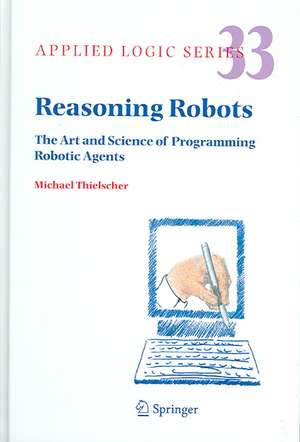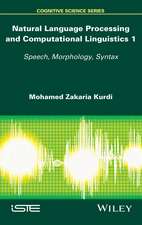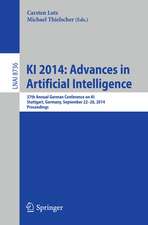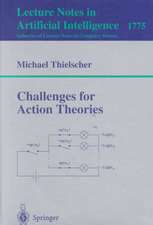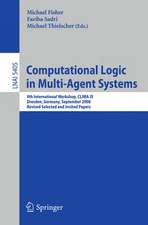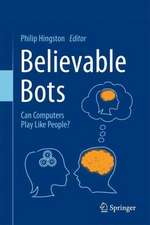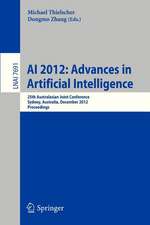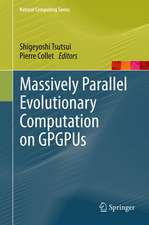Reasoning Robots: The Art and Science of Programming Robotic Agents: Applied Logic Series, cartea 33
Autor Michael Thielscheren Limba Engleză Hardback – 5 iul 2005
| Toate formatele și edițiile | Preț | Express |
|---|---|---|
| Paperback (1) | 390.84 lei 43-57 zile | |
| SPRINGER NETHERLANDS – 22 oct 2010 | 390.84 lei 43-57 zile | |
| Hardback (1) | 398.35 lei 43-57 zile | |
| SPRINGER NETHERLANDS – 5 iul 2005 | 398.35 lei 43-57 zile |
Din seria Applied Logic Series
- 18%
 Preț: 1109.26 lei
Preț: 1109.26 lei - 20%
 Preț: 996.22 lei
Preț: 996.22 lei - 18%
 Preț: 957.13 lei
Preț: 957.13 lei - 15%
 Preț: 646.75 lei
Preț: 646.75 lei - 18%
 Preț: 1225.62 lei
Preț: 1225.62 lei - 18%
 Preț: 956.33 lei
Preț: 956.33 lei - 18%
 Preț: 957.44 lei
Preț: 957.44 lei - 18%
 Preț: 959.98 lei
Preț: 959.98 lei - 15%
 Preț: 639.73 lei
Preț: 639.73 lei - 18%
 Preț: 945.79 lei
Preț: 945.79 lei - 18%
 Preț: 949.55 lei
Preț: 949.55 lei - 18%
 Preț: 952.40 lei
Preț: 952.40 lei - 15%
 Preț: 637.13 lei
Preț: 637.13 lei - 15%
 Preț: 639.59 lei
Preț: 639.59 lei - 20%
 Preț: 1001.86 lei
Preț: 1001.86 lei - 15%
 Preț: 645.28 lei
Preț: 645.28 lei - 18%
 Preț: 957.32 lei
Preț: 957.32 lei - 15%
 Preț: 649.06 lei
Preț: 649.06 lei - 18%
 Preț: 953.20 lei
Preț: 953.20 lei - 15%
 Preț: 589.65 lei
Preț: 589.65 lei - 15%
 Preț: 648.74 lei
Preț: 648.74 lei - 18%
 Preț: 1117.99 lei
Preț: 1117.99 lei - 20%
 Preț: 338.03 lei
Preț: 338.03 lei - 18%
 Preț: 956.03 lei
Preț: 956.03 lei - 18%
 Preț: 953.65 lei
Preț: 953.65 lei
Preț: 398.35 lei
Nou
Puncte Express: 598
Preț estimativ în valută:
76.22€ • 79.80$ • 63.07£
76.22€ • 79.80$ • 63.07£
Carte tipărită la comandă
Livrare economică 07-21 aprilie
Preluare comenzi: 021 569.72.76
Specificații
ISBN-13: 9781402030680
ISBN-10: 1402030681
Pagini: 344
Ilustrații: XIV, 328 p.
Dimensiuni: 156 x 232 x 23 mm
Greutate: 0.66 kg
Ediția:2005
Editura: SPRINGER NETHERLANDS
Colecția Springer
Seria Applied Logic Series
Locul publicării:Dordrecht, Netherlands
ISBN-10: 1402030681
Pagini: 344
Ilustrații: XIV, 328 p.
Dimensiuni: 156 x 232 x 23 mm
Greutate: 0.66 kg
Ediția:2005
Editura: SPRINGER NETHERLANDS
Colecția Springer
Seria Applied Logic Series
Locul publicării:Dordrecht, Netherlands
Public țintă
ResearchCuprins
Special Fluent Calculus.- Special FLUX.- General Fluent Calculus.- General FLUX.- Knowledge Programming.- Planning.- Nondeterminism.- Imprecision*.- Indirect Effects: Ramification Problem*.- Troubleshooting: Qualification Problem.- Robotics.
Recenzii
From the reviews:
"This book presents the ‘fluent calculus’ as one possible approach to solve the frame problem in artificial intelligence. … The book is very understandable and recommendable for anybody who wants to solve AI problems by means of predicate logics and logic programming. It shows that this approach is more and more applicable to the solution of real-world problems. It will be an excellent textbook for appropriate AI or robotics courses and very appropriate for graduate students." (Christian Posthoff, Zentralblatt MATH, Vol. 1092 (18), 2006)
"This book presents the ‘fluent calculus’ as one possible approach to solve the frame problem in artificial intelligence. … The book is very understandable and recommendable for anybody who wants to solve AI problems by means of predicate logics and logic programming. It shows that this approach is more and more applicable to the solution of real-world problems. It will be an excellent textbook for appropriate AI or robotics courses and very appropriate for graduate students." (Christian Posthoff, Zentralblatt MATH, Vol. 1092 (18), 2006)
Textul de pe ultima copertă
The book provides an in-depth and uniform treatment of a mathematical
model for reasoning robotic agents. The book also contains an introduction
to a programming method and system based on this model.
The mathematical model, known as the "Fluent Calculus,'' describes how
to use classical first-order logic to set up symbolic models of dynamic
worlds and to represent knowledge of actions and their effects. Robotic
agents use this knowledge and their reasoning facilities to make decisions
when following high-level, long-term strategies. The book covers
the issues of reasoning about sensor input, acting under incomplete
knowledge and uncertainty, planning, intelligent troubleshooting, and many
other topics.
The mathematical model is supplemented by a programming method which
allows readers to design their own reasoning robotic agents. The usage of
this method, called "FLUX,'' is illustrated by many example programs. The
book includes the details of an implementation of FLUX using the standard
programming language PROLOG, which allows readers to re-implement or
to modify and extend the generic system.
The design of autonomous agents, including robots, is one of the most
exciting and challenging goals of Artificial Intelligence. Reasoning robotic
agents constitute a link between knowledge representation and reasoning on
the one hand, and agent programming and robot control on the other. The
book provides a uniform mathematical model for the problem-driven,
top-down design of rational agents, which use reasoning for decision
making, planning, and troubleshooting. The implementation of the
mathematical model by a general PROLOG program allows readers to
practice the design of reasoning robotic agents. Since all implementation
details are given, the generic system can be easily modified and extended.
model for reasoning robotic agents. The book also contains an introduction
to a programming method and system based on this model.
The mathematical model, known as the "Fluent Calculus,'' describes how
to use classical first-order logic to set up symbolic models of dynamic
worlds and to represent knowledge of actions and their effects. Robotic
agents use this knowledge and their reasoning facilities to make decisions
when following high-level, long-term strategies. The book covers
the issues of reasoning about sensor input, acting under incomplete
knowledge and uncertainty, planning, intelligent troubleshooting, and many
other topics.
The mathematical model is supplemented by a programming method which
allows readers to design their own reasoning robotic agents. The usage of
this method, called "FLUX,'' is illustrated by many example programs. The
book includes the details of an implementation of FLUX using the standard
programming language PROLOG, which allows readers to re-implement or
to modify and extend the generic system.
The design of autonomous agents, including robots, is one of the most
exciting and challenging goals of Artificial Intelligence. Reasoning robotic
agents constitute a link between knowledge representation and reasoning on
the one hand, and agent programming and robot control on the other. The
book provides a uniform mathematical model for the problem-driven,
top-down design of rational agents, which use reasoning for decision
making, planning, and troubleshooting. The implementation of the
mathematical model by a general PROLOG program allows readers to
practice the design of reasoning robotic agents. Since all implementation
details are given, the generic system can be easily modified and extended.
